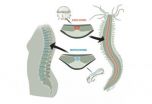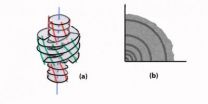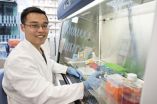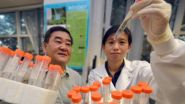(Press-News.org) Thoughts of the family tree may not be uppermost in the mind of a person suffering from a slipped disc, but those spinal discs provide a window into our evolutionary past. They are remnants of the first vertebrate skeleton, whose origins now appear to be older than had been assumed. Scientists at the European Molecular Biology Laboratory (EMBL) in Heidelberg, Germany, have found that, unexpectedly, this skeleton most likely evolved from a muscle. The study, carried out in collaboration with researchers at the Howard Hughes Medical Institute in Janelia Farm, USA, is published today in Science.
Humans are part of a group of animals called chordates, whose defining feature is a rod of cartilage that runs lengthwise along the middle of their body, under their spinal chord. This structure, called the notochord, was the first vertebrate skeleton. It is present in human embryos, and is replaced with the backbone as we develop, with the cartilage reduced to those tell-tale discs. Since starfish, sea urchins and related animals have no such structure, scientists assumed the notochord had emerged in a relatively recent ancestor, after our branch of the evolutionary tree split away from the 'starfish branch'.
"People simply haven't been looking beyond our direct relatives, but that means you could be fooled, if the structure appeared earlier and that single group lost it," says Detlev Arendt from EMBL, who led the study. "And in fact, when we looked at a broader range of animals, this is what we found."
Antonella Lauri and Thibaut Brunet, both in Arendt's lab, identified the genetic signature of the notochord – the combination of genes that have to be turned on for a healthy notochord to form. When they found that the larva of the marine worm Platynereis has a group of cells with that same genetic signature, the scientists teamed up with Philipp Keller's group at Janelia Farm to use state-of-the-art microscopy to follow those cells as the larva developed. They found that the cells form a muscle that runs along the animal's midline, precisely where the notochord would be if the worm were a chordate. The researchers named this muscle the axochord, as it runs along the animal's axis. A combination of experimental work and combing through the scientific literature revealed that most of the animal groups that sit between Platynereis and chordates on the evolutionary tree also have a similar, muscle-based structure in the same position.
The scientists reason that such a structure probably first emerged in an ancient ancestor, before all these different animal groups branched out on their separate evolutionary paths. Such a scenario would also explain why the lancelet amphioxus, a 'primitive' chordate, has a notochord with both cartilage and muscle. Rather than having acquired the muscle independently, amphioxus could be a living record of the transition from muscle-based midline to cartilaginous notochord.
The shift from muscle to cartilage could have come about because a stiffened central rod would make swimming more efficient, the scientists postulate.
INFORMATION:
A video relating to this study can be found at: http://youtu.be/78zuEh6EoKE.
From worm muscle to spinal discs
An evolutionary surprise
2014-09-12
ELSE PRESS RELEASES FROM THIS DATE:
New family of materials for energy-efficient information storage and processing
2014-09-12
Switching the polarity of a magnet using an electric field (magnetoelectric memory [MEM] effect), can be a working principle of the next-generation technology for information processing and storage. Multiferroic materials are promising candidates for the MEM effect, due to the coexistence of electric and magnetic orders. On the other hand, the coexistence of spontaneous electric and magnetic polarizations is rare in known materials, which hinders the application potential of the MEM effect. This article briefly reviews a new family of multiferroic materials—hexagonal rare ...
Conjecture on the lateral growth of Type I collagen fibrils
2014-09-12
Whatever the origin and condition of extraction of type I collagen fibrils, in vitro as well as in vivo, the radii of their circular circular cross sections stay distributed in a range going from 50 to 100 nm for the most part of them. Jean Charvolin and Jean-Francois Sadoc from the solid state physique laboratory at the Paris-Sud University propose therefore that, once the growth of the fibrils has been triggered by external biological factors, their lateral size be limited by internal physical stresses generated during the growth. Their conjecture is based ...
Extension of standard model by knot algebra
2014-09-12
This paper makes a connection between the quantum group SLq(2), which described knots, and the elementary particles of the standard model. The elements of the fundamental (j = 1/2) representation of SLq(2) are interpreted as creation operators for preons. The preons interact through a preonic vector field defined by elements of the adjoint (j = 1) representation. The leptons and quarks then appear (as required by the electroweak data) as elements of the j = 3/2 representation. Unexpectedly the electroweak quantum numbers of the so defined preons, leptons, and quarks agree ...
Scientists show that nicotine withdrawal reduces response to rewards across species
2014-09-12
Cigarette smoking is a leading cause of preventable death worldwide and is associated with approximately 440,000 deaths in the United States each year, according to the U.S. Centers for Disease Control and Prevention, but nearly 20 percent of the U.S. population continues to smoke cigarettes. While more than half of U.S. smokers try to quit every year, less than 10 percent are able to remain smoke-free, and relapse commonly occurs within 48 hours of smoking cessation. Learning about withdrawal and difficulty of quitting can lead to more effective treatments to help smokers ...
Favoritism linked to drug use in 'disengaged' families
2014-09-12
Before you revive the debate about which sibling in your family is the favorite, you'll want to know what the latest research shows.
Brigham Young University professor Alex Jensen analyzed 282 families with teenage siblings for a study that appears in the Journal of Family Psychology. Favoritism in parenting is a complex topic for sure, but here are some important take-aways.
Does it really matter?
Yes, at least for some families. Jensen looked at perceived preferential treatment in different types of family dynamics. For families that aren't very close to each other ...
Brain inflammation dramatically disrupts memory retrieval networks, UCI study finds
2014-09-12
Irvine, Calif., Sept. 10, 2014 — Brain inflammation can rapidly disrupt our ability to retrieve complex memories of similar but distinct experiences, according to UC Irvine neuroscientists Jennifer Czerniawski and John Guzowski.
Their study – which appears today in the Journal of Neuroscience – specifically identifies how immune system signaling molecules, called cytokines, impair communication among neurons in the hippocampus, an area of the brain critical for discrimination memory. The findings offer insight into why cognitive deficits occurs in people undergoing chemotherapy ...
No innocent bystander: Cartilage contributes to arthritis
2014-09-12
Melbourne researchers have discovered that cartilage plays an active role in the destruction and remodelling of joints seen in rheumatoid arthritis, rather than being an 'innocent bystander' as previously thought.
Dr Tommy Liu, Professor Ian Wicks, Dr Kate Lawler, Dr Ben Croker and colleagues from the Walter and Eliza Hall Institute made the discovery while investigating the role of the protein SOCS3 in controlling inflammation during rheumatoid arthritis. The study was published in the journal Arthritis and Rheumatology.
Rheumatoid arthritis affects more than 400,000 ...
A meta-analysis of 3 types of peer norms and their relation with adolescent sexual behavior
2014-09-12
Researchers at Utrecht University and the New York State Psychiatric Institute collaborated on a meta-analysis of research on adolescent sexual behavior. The goal was to analyze how this behavior is related to adolescents' perceptions of three types of sexual peer norms, including how sexually active their peers are, how much their peers would approve of being sexually active, or how much they feel pressured by their peers to have sex. Awareness that these are different ways in which peers can affect adolescents' sexual behaviors is important for parents, teachers, and ...
Protein appears to protect against bone loss in arthritis
2014-09-12
AUGUSTA, Ga. – A small protein named GILZ appears to protect against the bone loss that often accompanies arthritis and its treatment, researchers report.
Arthritis as well as aging prompt the body to make more fat than bone, and the researchers have previously shown GILZ can restore a more youthful, healthy mix. It also tamps down inflammation, a major factor in arthritis.
Now they have early evidence that GILZ might one day be a better treatment option for arthritis patients than widely used synthetic glucocorticoids, which actually increase bone loss, said Dr. Xingming ...
Dendritic cells affect onset and progress of psoriasis
2014-09-12
Different types of dendritic cells in human skin have assorted functions in the early and more advanced stages of psoriasis report researchers in the journal EMBO Molecular Medicine. The scientists suggest that new strategies to regulate the composition of dendritic cells in psoriatic skin lesions might represent an approach for the future treatment of the disease.
"We urgently need new ways to treat psoriasis, treatments that will deliver improved benefits to patients and reduce the incidence of known side effects for existing drugs," says EMBO Member Maria Sibilia, ...
LAST 30 PRESS RELEASES:
Scientists trace microplastics in fertilizer from fields to the beach
The Lancet Obstetrics, Gynecology, & Women’s Health: Taking paracetamol during pregnancy does not increase risk of autism, ADHD or intellectual disabilities, confirms new gold-standard evidence review
Taking paracetamol during pregnancy does not increase risk of autism, ADHD or intellectual disabilities
Harm reduction vending machines in New York State expand access to overdose treatment and drug test strips, UB studies confirm
University of Phoenix releases white paper on Credit for Prior Learning as a catalyst for internal mobility and retention
Canada losing track of salmon health as climate and industrial threats mount
Molecular sieve-confined Pt-FeOx catalysts achieve highly efficient reversible hydrogen cycle of methylcyclohexane-toluene
Investment in farm productivity tools key to reducing greenhouse gas
New review highlights electrochemical pathways to recover uranium from wastewater and seawater
Hidden pollutants in shale gas development raise environmental concerns, new review finds
Discarded cigarette butts transformed into high performance energy storage materials
Researchers highlight role of alternative RNA splicing in schizophrenia
NTU Singapore scientists find new way to disarm antibiotic-resistant bacteria and restore healing in chronic wounds
Research suggests nationwide racial bias in media reporting on gun violence
Revealing the cell’s nanocourier at work
Health impacts of nursing home staffing
Public views about opioid overdose and people with opioid use disorder
Age-related changes in sperm DNA may play a role in autism risk
Ambitious model fails to explain near-death experiences, experts say
Multifaceted effects of inward foreign direct investment on new venture creation
Exploring mutations that spontaneously switch on a key brain cell receptor
Two-step genome editing enables the creation of full-length humanized mouse models
Pusan National University researchers develop light-activated tissue adhesive patch for rapid, watertight neurosurgical sealing
Study finds so-called super agers tend to have at least two key genetic advantages
Brain stimulation device cleared for ADHD in the US is overall safe but ineffective
Scientists discover natural ‘brake’ that could stop harmful inflammation
Tougher solid electrolyte advances long-sought lithium metal batteries
Experts provide policy roadmap to reduce dementia risk
New 3D imaging system could address limitations of MRI, CT and ultrasound
First-in-human drug trial lowers high blood fats
[Press-News.org] From worm muscle to spinal discsAn evolutionary surprise






